By Michael Smith, North American Correspondent, MedPage Today
Published: March 04, 2012
Reviewed by Robert Jasmer, MD; Associate Clinical Professor of Medicine, University of California, San Francisco.
Action Points
- A non-invasive diagnostic method, ultrasound-based transient elastography, can accurately pick up fibrosis and cirrhosis in patients with recurrent hepatitis C after a liver transplant.
- Note that the major limitation of the technique lies in interpreting results that correspond to intermediate stages of fibrosis.
A non-invasive diagnostic method can accurately pick up fibrosis and cirrhosis in patients with recurrent hepatitis C after a liver transplant, researchers reported.
In a meta-analysis, ultrasound-based transient elastography had excellent diagnostic accuracy in detecting cirrhosis, according to Jayant Talwalkar, MD, and colleagues at the Mayo Clinic in Rochester, Minn.
The major limitation of the technique lies in interpreting results that correspond to intermediate stages of fibrosis, Talwalkar and colleagues reported in the March issue of Liver Transplantation.
"Further studies that confirm our results could highlight the importance of [transient elastography] as a diagnostic tool for liver transplant recipients" with recurrent hepatitis C, Talwalkar said in a statement.
Hepatitis recurrence is common among transplant patients and is "universal" among those who are positive for hepatitis C RNA at the time of transplant, the researchers noted.
And the development of fibrosis is faster in the transplanted organ than in the native liver, resulting in rapid cirrhosis and graft failure. The "only practical approach for improving ... clinical outcomes" is early recognition of patients with progressive recurrent disease, Talwalkar and colleagues argued.
The gold standard for diagnosing fibrosis and cirrhosis is the liver biopsy, they noted, since the degree of inflammation and the stage of fibrosis can be directly measured.
And the stage of fibrosis is needed for the timing of antiviral therapy if patients are eligible, they added.
But there is evidence that liver biopsies -- as well as having the risk associated with an invasive procedure -- may actually understage fibrosis up to 30% of the time, Talwalkar and colleagues said.
To see how well transient elastography performs, they conducted a systematic literature review that turned up six high-quality studies of the issue, five with data on fibrosis and five with data on cirrhosis.
The studies included 470 patients, with a range from 50 to 124. Diagnostic cut-offs for significant fibrosis ranged from 7.1 to 10.1 kilopascals; the values for cirrhosis ranged from 10.5 to 26.5.
Analysis showed that transient elastography had a sensitivity and specificity of 83%, respectively, for detecting fibrosis. The diagnostic odds ratio was 30.5.
For cirrhosis, the sensitivity was 98% and specificity was 84%. The diagnostic odds ratio was 130.
The analysis "yielded excellent summary estimates of the sensitivity and specificity for detecting cirrhosis and good estimates for detecting significant fibrosis," the researchers concluded.
They cautioned that, for both patient subgroups, the results demonstrated varying degrees of statistical heterogeneity, probably owing to such things as differences in study design and "subtle variations in the technical performances" of the two diagnostic methods between studies.
The researchers did not report external support for the study or any potential conflicts.
Primary source: Liver Transplantation
Source reference:
Adebajo CO, et al "Ultrasound-based transient elastography for the detection of hepatic fibrosis in patients with recurrent hepatitis C virus after liver transplantation: a systematic review and meta-analysis" Liver Transpl 2012; 18: 323-331.

No comments:
Post a Comment